From 1934 through to the mid-1940s, the Derry Journal regularly carried letters from a leper camp in Nyenga, Uganda. The letter writer was Fr Barney MacLoone of Glenties, Co Donegal, who had left for Africa immediately after his ordination as a Mill Hill Missionary in 1911.
Uganda had been a British colony, or, in the soft-speak of imperialism, a “protectorate”, since 1894, when London moved to secure the Upper Nile. It was riven by religious divisions, between Muslims, competing Christian sects, and “pagans”, adherents of indigenous religions. And it was plagued too by disease. Sleeping sickness killed 250,000 people in 1900-1920; leprosy was endemic, its victims shunned.
MacLoone initially ministered in Buganda, a kingdom on the northern shore of Lake Victoria. From there, in 1915, he started to send occasional letters to the Journal, describing his work for “the faith” and promising benefactors to remember them in his masses and that “our wee dusky children” would say “their own good wee prayers” for them too.
In the latter stages of World War I, he served as a British Army chaplain in German East Africa, but then resumed missionary work, ultimately at Iganga, in Uganda’s eastern province. And all the while, he kept writing home.
He himself came home in late 1924, suffering from chronic intestinal trouble, probably complications of typhoid fever, for which he received treatment in Dublin.
He also travelled, giving lectures, illustrated with “lantern slides” and punctuated by music on the gramophone. Then, in October 1927, he returned to Uganda, to teach at St Joseph’s Seminary in Nyenga.
Appeals for funds from “the wee Donegal priest”, as he now styled himself, began to appear in the Journal; but from 1934, when he was appointed chaplain of St Francis’s Leper Hospital, a facility established by the Franciscan Sisters, and an associated camp, his letters became more frequent.
Although essentially solicitations, MacLoone's letters do illuminate life in the leper camp
Barney MacLoone wrote to other regional and national newspapers; indeed, his letters appeared in the international press, one even making the New York Times. But the Journal was his preferred paper. And he knew its readership – the Catholics of Derry, Donegal, and west Tyrone.
In 1935, he described calling to see “a Protestant leper”, an old man named Joseph, who was near death.
“In the beginning, he did not want to hear anything at all about religion. He kept on telling me that he had been baptized a Protestant – that baptism was received only once.”
The wee Donegal priest was having none of it and, while Joseph was dying, he was “storming Heaven, the Sacred Heart, and Our Lady for his conversion”.
It worked: all of a sudden, Joseph asked to become a Catholic. A few hours later, he died a Catholic leper.
MacLoone assured the Journal’s readers, Joseph was now in Heaven, cured of leprosy and praying for the benefactors of the hospital in Derry and Donegal. He knew he was praying for them, because, before he died, he had made him promise to do so. And he thanked them again, “from the very bottom of my Donegal heart”, for their donations.
Letters from Nyenga were sure to reach the Journal around Christmas, St Patrick’s Day and Easter, but they arrived throughout the year. Funds were always urgently needed. Often, a postscript noted that a letter sent airmail would reach Uganda in a week; by steamer and train, it would take three weeks.
Although essentially solicitations, MacLoone’s letters do illuminate life in the leper camp. One described Santa Claus’s arrival, others sports days and St Patrick’s Day parades. Photographs also reached editors’ desks, as did the lepers’ handiwork. In 1934 the Irish Press received, from MacLoone, “a calendar made by his little black friends, beautifully illustrated by a picture of wee black boy”.
Those letters from Nyenga, indeed, all MacLoone’s letters, give an impression of a lighthearted man.
“The Dark Continent”, he wrote in his very first letter, “is not a quarter as black as it is painted.”
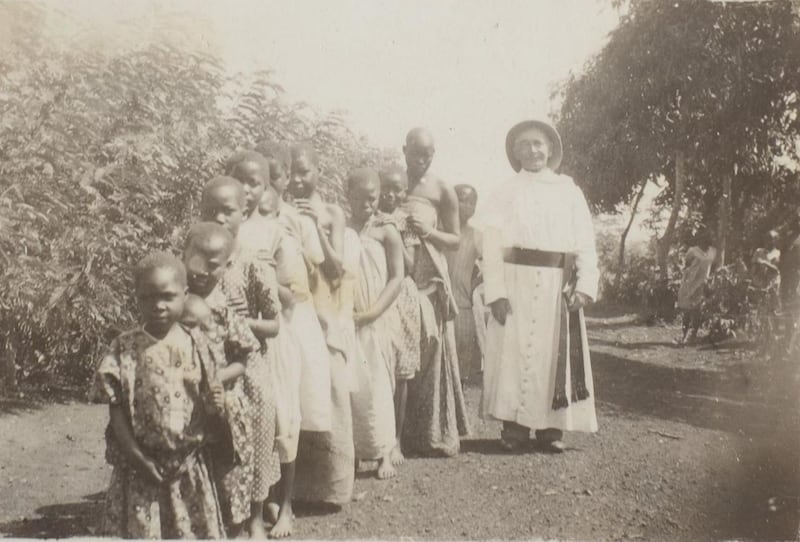

Decades later, in 1936, noting that the Ugandans called him Pere Makerone, he joked that he sounded like “an Irish Italian”. And the letters hint too that he kicked against convention.
Rather than catechize children by asking questions, as was done in Ireland, he answered questions that they asked him: “Was Our Lord, as man, white or black? . . . In Heaven, do they speak Luganda? Will we understand the language spoken? . . . When we get to Heaven, will we become white or will we always remain black?”
Africa changed missionaries and MacLoone’s letters reveal increasing respect for Ugandan culture. He became proficient in native languages and, in Nyenga, he taught children a greeting and farewell to sing in Luganda: Kulika, kulika, kulika, Basebo. Tusanyuse kulaba. “Greetings, greetings, greetings, Sirs. We are glad to see you.” Mweraba, mweraba, mwereba, Basebo. Katondo a kukume. “Farewell, farewell, farewell, Sirs. God guard you.”
Also, in July 1934 MacLoone asked the Journal’s readers for money to purchase two gramophones, one for the children and one for the elderly, so that “my darling lepers” could listen to songs in Luganda: “They love to hear their own native songs on the gramophone”. And maybe money for a third gramophone, for himself, that he might listen to John McCormack.
The donations came.
In December 1935, with benefactions from Ireland, MacLoone purchased “things to make the lepers happy for Christmas .. . meat, fish, bread and cakes, oranges, sugar cane . . . tobacco and cigarettes and some pipes for the old people.”
Music was not forgotten: “I bought thirty-four Luganda records for them, native songs in their own language. They heard them for the first time on Christmas Eve. Young and old sat down listening to them and enjoying them. I often brought them down nice European records, but, not knowing English, after about ten minutes they got tired of them and went away. But now they don’t want to go away, and they hear their own songs in Luganda.”
And there was respect too for Ugandans’ reason and understanding: in 1935, when Italy was going to war in Abyssinia, MacLoone sent the Journal a list of questions asked of missionaries. The first was “Why do Whites, who are so well-educated –-not like we Blacks – begin another war?”
After suffering two strokes, MacLoone came home in 1946 to live, with his sister Kate, in Glenties. When he died there in 1950, obituaries claimed that he had written half a million letters.
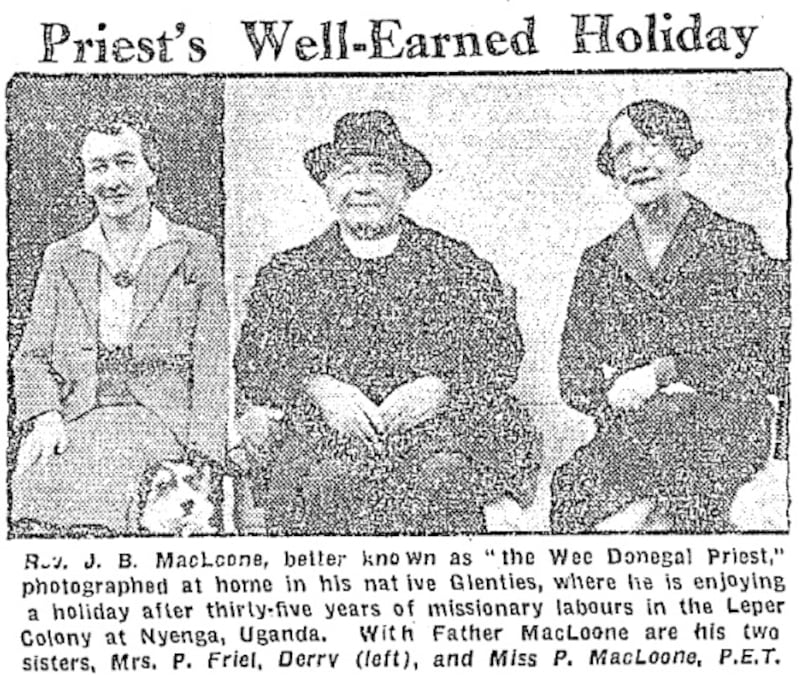
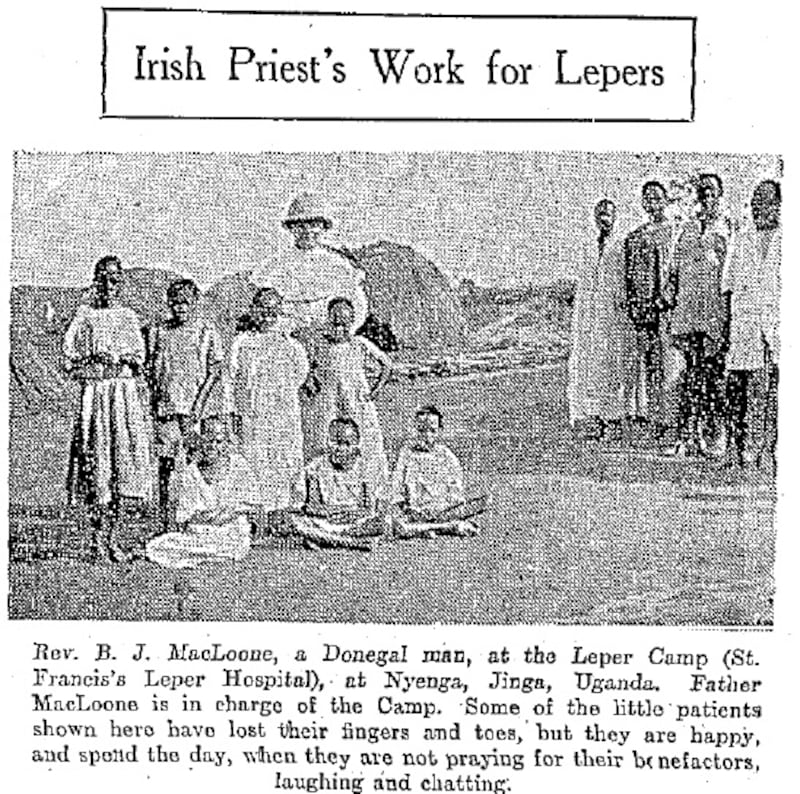
Among the mourners at Barney MacLoone’s funeral was his nephew, 21-year-old Brian Friel, a teacher in Derry.
And “the wee Donegal priest known to millions” would today be unknown, but that Friel based a character in Dancing at Lughnasa (1990) upon him.
In the play, set in 1936, a decade before MacLoone’s return, Fr Jack has just arrived from Uganda. He had “gone native” there and now, at home, his attitude to sex and spirituality chafes against his schoolteacher sister’s buttoned-up Catholic sensibility. And it is the older magic – bonfires in the back hills celebrating Lughnasa – that animates him.
Critics have long had difficulty with Fr Jack. In an otherwise glowing review of the original Abbey production, Fintan O’Toole identified the character as a weakness, an intrusion of “Northern” politics into what he represented as a “Southern play”: “an uncomfortable mixture of whimsicality on the one hand, and a metaphorical version of a Field Day pamphlet on the other”. Fr Jack represents “a layer of politics in the play that is never fully integrated and rooted”.
Implicit here is the notion, fanciful but familiar, that Ireland’s most northerly county is culturally “Southern”, fundamentally different to Derry and Tyrone – a notion refuted by Friel’s family history and the circulation of the Journal.
And implicit too is a fallacy that colonialism had no malign effect on the South. Of course, O’Toole was writing in 1990, two decades into the Troubles, against which the Southern establishment sought to inoculate itself, routinely distancing itself from what was happening “up there”, a phrase still used by Mícheál Martin, that is, over the Border – a border that most Southerners must twice cross to reach Friel’s “Ballybeg”. And so it is a cultural fallacy that was central to a political strategy.
In fairness, Brexit has lately relieved O’Toole of his internalised partitionism. Still, his review threw up a ball that other critics have continued to kick. The priest, Stephanie Boeninger argued in the Irish University Review in 2018, is “implausible” and she and other critics make much of his name being Jack not Barney, while his sisters retain the names of Friel’s mother and aunts.
The diocesan clergy often treated returned missionaries as ministers of a lesser god and there was no public reception in Glenties in 1946 for the leper priest long valorised in his absence
Paradoxically, however, there are more verifiable symmetries between Jack and Barney than between Jack’s sisters and “those five brave Glenties women” to whom Lughnasa is dedicated.
He is a priest, born in the 1880s, who went to Uganda in 1911, served as a military chaplain in the first World War, interested himself in African culture, worked with lepers, wore funny hats, featured in the local press, and everyone was proud of him, until he returned home, broken in health.
For sure, there are differences – for instance, MacLoone did not, like Jack, spend his entire career with lepers –but strikingly, Jack bears a closer resemblance to MacLoone than Chris, who has a child out of wedlock, bears to Friel’s mother. How is Jack “implausible” and not Chris?
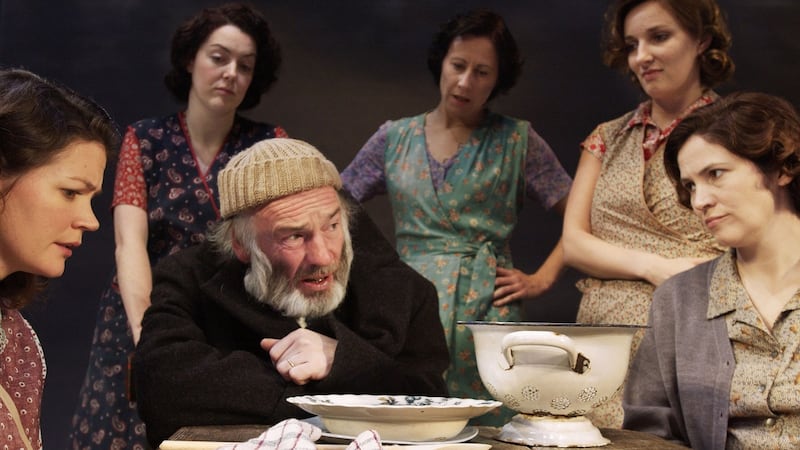
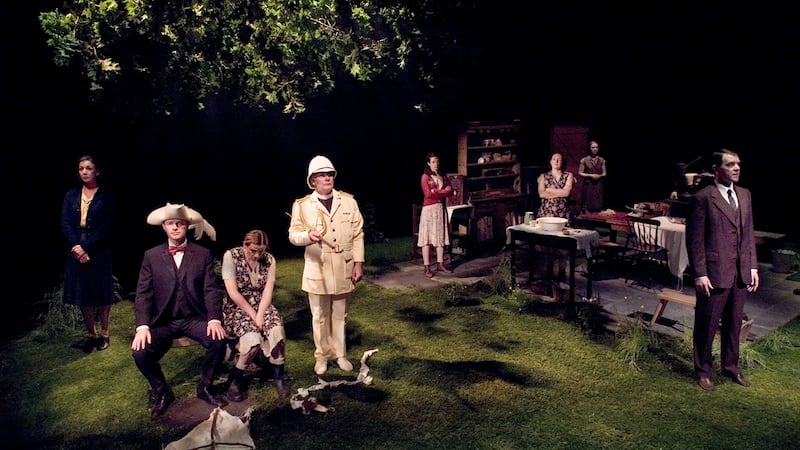
In truth, no critic has determined whether Friel was onto something when he wondered, as he worked on the play, if his uncle had been sent home for “going native”, which is the explanation for Jack’s return in Lughnasa.
And while MacLoone did return, like Jack, in poor health, we do not, perhaps cannot know if, at home, he shuffled “from room to room as if searching for something but couldn’t remember what” or continued “his own distinctive spiritual search”.
This much we do know: the diocesan clergy often treated returned missionaries as ministers of a lesser god and there was no public reception in Glenties in 1946 for the leper priest long valorized in his absence.
But can we ever know if MacLoone, like Jack, went native at home, that is, found the bonfires in the back hills more meaningful than the chapel-centred Catholicism in the town?
And would knowing have any bearing on audiences’ appreciation of the play? Certainly, fact-checking – comparing art and history, the stuff of much Friel criticism since Translations (1980) – runs athwart Dancing at Lughnasa.
After all, at the end, Michael – Chris’s son, born like Friel in 1929 – acknowledges that when he recalls the summer of 1936 “atmosphere is more real than incident and everything is simultaneously actual and illusory.”




















